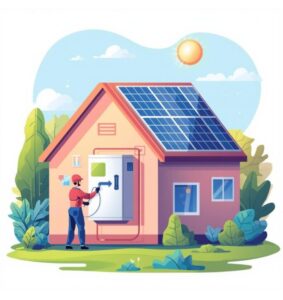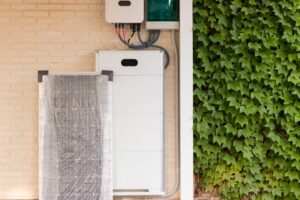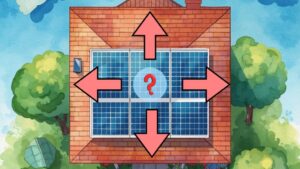Going solar often gets compared to buying a home or buying a car. And yes, similarities exist with both similes, but the experience truly falls into its own category. With all its novelty, the experience can be surprising in good and bad ways. In this article, I want to mitigate some of those bad surprises by explaining how to troubleshoot your system if you suspect something is wrong. Hopefully, it’ll avoid unnecessary headaches and a service call or two.
- Consumption Neglect
This is the second most common service call we receive. A homeowner will say their system isn’t working because their energy bill has been significantly higher over the past few months. If they’re one of our customers, we take a look at their monitoring portal. We check their solar production as well as how much energy they’ve been consuming. The consumption amount will include solar energy used and, if there’s any, electricity used from the utility company. We then compare the recent usage with the amount before going solar. Usually, the amount of electricity they’re using doubles, sometimes even triples. It’s an odd phenomenon we call consumption neglect.
Basically, when some people go solar they’ll unintentionally use more electricity. This of course comes with quite a shock (pun not intended) What? I went solar, and now my energy bill is the same as before solar but now I’m also paying for my solar panels. It’s understandable to be upset and hopefully there’s comfort in knowing others go through consumption neglect. Once people are aware of their increased energy use, they take a more consciousness approach and revert back to their normal consumption.
- Clipping


Clipping refers to the phenomenon of your solar panels producing more electricity at a time than their inverters can convert to AC power. If your system was designed properly this may occasionally happen, but shouldn’t occur regularly. If you find your system is clipping on a daily basis then whoever designed your layout used an inadequate inverter to do so. We recommend calling your original installer or reaching out to us to give it a closer look.
A question you may be asking yourself, why wouldn’t I want an inverter that will always be able to convert all the power produced by the solar panels? To put it simply, it’s a lot more expensive for you, the homeowner, and if the clipping only happens once a week for 1-3 years, the panel production will go down a little with degradation, and clipping won’t be a problem. You may have lost tens or a hundred of dollars due to clipping, but you saved a lot more by not getting the upgrade. Inverters can be pricey, but where it really saves money is the electrical upgrade needed for your home. Clipping in moderation is a good thing.
- No comm service
If you have a SolarEdge system installed 3 or more years ago, then you will know exactly what we’re talking about. Recently to this video being published, SolarEdge has informed its users that they are discontinuing their 2G comm service. What this means is, if your system was installed a few years ago or more, there’s a possibility that your monitoring portal can’t show your system’s production. Your system is likely still producing power, you just can’t monitor the production unless you have your system connected to your wifi via an ethernet cable. In which case, you can continue to monitor your system.
Solar Edge Pros can install the necessary material to make your monitoring system reliable again. Don’t have access to your monitoring portal? No problem! Here at Solar Edge Pros we can help you access the monitoring portal at no charge to you. That’s right, we do it for free for property owners in the state of Texas.
{"question":"Clipping refers to: ","answers":["A solar panel hair cut","The reduction in solar production from the solar system's inverter","The trimming from a solar panel","A piece of a solar panel"],"correctAnswer":1,"bgColor":"#e5e5e5"}- Shading
Before calling the solar repair guys, it could be worth asking, did my tree get bigger? Shading is not a frequent call for service, but it does happen. A homeowner will notice on their monitoring portal that a few panels aren’t producing as much power as the others. They call us to see if something is wrong with their inverters, we make the drive out there and then boom, we see a massive tree blocking their panels. Yup, that’s your problem.
Another issue related to shading could be debris. When there’s a lot of dust and pollen in the air, it can cover your panels and reduce your production. The reduction won’t be massive, but it is enough for some of our more scrupulous homeowners to ask about solutions. A high-pressure wash down is enough to do the trick. We talk more about this in our DIY Maintenance post.
- Heat
This one is really for those techy homeowners that want live updates on their system’s production on a daily basis. Essentially, panels perform best around 77 degrees Fahrenheit, any higher and production starts to decrease. Not by a lot, but enough to make the analyst types stop and go: It’s a sunny day. Why is my system’s production less than it was two months ago when it was also a sunny day?
Good chance it was a hotter day and the system’s ability to drive the electrons through the panels busbars was not as stable. The heat causes electrons to move around more. The best way to determine your system’s heat tolerance is by looking at the manufacturer’s data sheet. There you’ll see a term called “Temperature coefficient” (learn more about that here).
- Roof Replacement
The most common service call we receive is for – what we call – the de-reinstall. This is where a homeowner wants to replace their roof, and in order for the roofing company to do so, they need a solar installation company to remove the panels and then reinstall them. This service is often covered by the home insurance, so the homeowners don’t have to pay anything extra out of pocket.
Hopefully these six solutions help resolve your problem, however if an issue persists it’s always acceptable to call your installer with solar questions. Stellar solar companies always help customers appreciate the sunny days.






